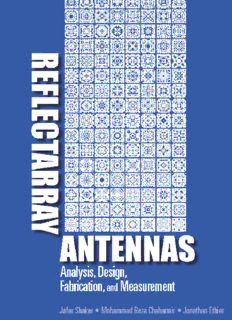
Reflectarray Antennas Analysis, Design, Fabrication, and Measurement PDF
Preview Reflectarray Antennas Analysis, Design, Fabrication, and Measurement
Reflectarray Antennas Analysis, Design, Fabrication, and Measurement For a listing of recent titles in the Artech House Antennas and Propagation Series, turn to the back of this book. Reflectarray Antennas Analysis, Design, Fabrication, and Measurement Jafar Shaker Mohammad Reza Chaharmir Jonathan Ethier Library of Congress Cataloging-in-Publication Data A catalog record for this book is available from the U.S. Library of Congress. British Library Cataloguing in Publication Data A catalog record for this book is available from the British Library. ISBN-13: 978-1-60807-499-0 Cover design by Vicki Kane © 2014 Artech House All rights reserved. Printed and bound in the United States of America. No part of this book may be reproduced or utilized in any form or by any means, elec- tronic or mechanical, including photocopying, recording, or by any information storage and retrieval system, without permission in writing from the publisher. All terms mentioned in this book that are known to be trademarks or service marks have been appropriately capitalized. Artech House cannot attest to the accuracy of this information. Use of a term in this book should not be regarded as affecting the validity of any trademark or service mark. 10 9 8 7 6 5 4 3 2 1 To our wives Contents CHAPTER 1 Introduction 1 1.1 General Background 1 1.2 Why Reflectarrays? 2 1.3 The Structure of the Book 4 References 6 CHAPTER 2 Fundamentals of Reflectarray and General Design Guidelines 9 2.1 General Design Equations 9 2.2 Aperture Efficiency of Reflectarray and Comparison with Conventional Parabolic Reflector 13 2.2.1 Illumination Efficiency 13 2.2.2 Spillover Efficiency 14 2.2.3 Polarization Efficiency 15 2.2.4 Phase Efficiency 16 2.2.5 Blockage Efficiency 17 2.2.6 Dielectric and Conductor Loss 17 2.3 Simplest Reflectarray Cell Element: Microstrip Patch 18 2.3.1 Phase Versus Length Curves 19 2.3.2 General Trends for Phase-Length Characteristics of the Patch 20 References 24 CHAPTER 3 Different Types of Cell Elements for Reflectarrays 25 3.1 Resonant Cell Elements 25 3.1.1 Patch Element 26 3.1.2 Multiresonant Patch Cell Elements 28 3.2 Loop Elements 31 3.3 Phase Shift by Loading Resonant Elements 35 3.4 Volumetric Cell Elements 41 3.5 Subwavelength, Coupled Resonant Elements 42 3.5.1 Subwavelength Patches and Loops 42 3.5.2 Advanced Subwavelength Elements 46 vii viii Contents 3.5.3 Subwavelength Fragmented Elements 50 3.5.4 Array Thinning with Subwavelength Elements 55 References 59 CHAPTER 4 Different Types of Reflectarrays 63 4.1 Multiband Reflectarray 63 4.1.1 Single-Layer, Dual-Band Reflectarray with Interlaced Elements 63 4.1.2 Dual-Band, Double-Layer Reflectarray with Stacked Elements 67 4.1.3 FSS-Backed Reflectarray 69 4.2 Circularly Polarized Reflectarrays 72 4.3 Folded Reflectarray 77 4.4 Power Combining and Beam Splitting 80 4.5 Subreflectarray Structures 83 4.6 Beam Shaping 85 References 93 CHAPTER 5 Numerical Methods: Pathway to a Better Understanding of Reflectarrays 95 5.1 Application on the Method of Moment in the Analysis of Reflectarrays 95 5.2 Application of Circuit Models in the Analysis of Reflectarray Cell Element 100 5.3 Calculation of the Radiation Pattern of a Reflectarray 102 5.4 Application of Commercial Software in the Design and Analysis of Reflectarrays 107 5.5 The Infinite-from-Finite Method 110 5.6 Characteristic Mode Analysis of Periodic Structures 113 5.6.1 Fundamentals of Characteristic Mode Analysis 113 5.6.2 Efficient and Unambiguous Extraction of Reflection and Transmission Coefficients 114 References 117 CHAPTER 6 Reflectarray Bandwidth 119 6.1 Introduction 119 6.2 Bandwidth Limitation by the Reflectarray Element 121 6.3 Multiresonant Elements 123 6.3.1 Square-Loop Cell Element 123 6.3.2 Cross-Loop Cell Element 124 6.3.3 Hybrid Cell Element 124 6.4 Subwavelength Elements 125 6.5 Bandwidth Limitation by Differential Spatial Phase Delay 128 6.5.1 Verification of the Optimization Method 130 6.6 Impact of the Feed Position on the Bandwidth of Broadband Reflectarrays 135 References 138 Contents ix CHAPTER 7 Reflectarrays on Lossy Substrates 141 7.1 Introductory Remarks 141 7.2 A Description of the Loss Mechanism in Reflectarray Elements 141 7.3 Cataloging Elements Based on Loss Performance 142 7.3.1 Loss Performance of Narrowband Versus Wideband Elements 142 7.3.2 Loss Performance of Subwavelength, Coupled Resonant Elements 144 7.4 Frequency Dispersion of the Reflection Phase and Its Relationship with Loss 146 7.4.1 Qualitative Description of Loss Reduction 146 7.4.2 Quantitative Description of Loss Reduction 148 7.5 High-Performance Reflectarrays Using Lossy Substrates 151 7.6 Concluding Remarks 155 References 156 CHAPTER 8 Transmitarray 159 8.1 Introduction 159 8.2 Antenna-Filter-Antenna Transmitarray 159 8.3 Multilayer Transmitarray Using Matching Impedance 163 8.3.1 Transmitarray with Multilayer of Dipoles 163 8.3.2 Dual-Band Transmitarray 167 8.3.3 Multilayer Transmitarray Using Loop Elements 168 8.3.4 Phase Shifting Surface (PSS) 173 References 177 CHAPTER 9 New Techniques for Beam Switching or Steering in Reflectarray and Transmitarray 179 9.1 Introduction 179 9.2 Mechanical Techniques for Beam Scanning of Reflectarray and Transmitarray 180 9.2.1 A Mechanical Method for Beam Switching of Reflectarray 181 9.2.2 A Mechanical Method for Beam Scanning of Transmitarray 183 9.3 Reflectarray Beam Scanning Using Reconfigurable Materials 184 9.3.1 Photonically Controlled Method for Beam Scanning of Reflectarray 184 9.3.2 Reconfigurable Reflectarrays Using Liquid Crystals 187 9.4 Electronically Controlled Reflectarray Antennas 190 9.5 Dual Reflectarray Antenna for Beam-Scanning Application 195 References 196 CHAPTER 10 Fabrication Technologies 199 10.1 Outline of Reflectarray Fabrication Technologies 199 10.2 Element Performance and Minimum Feature Size 200
